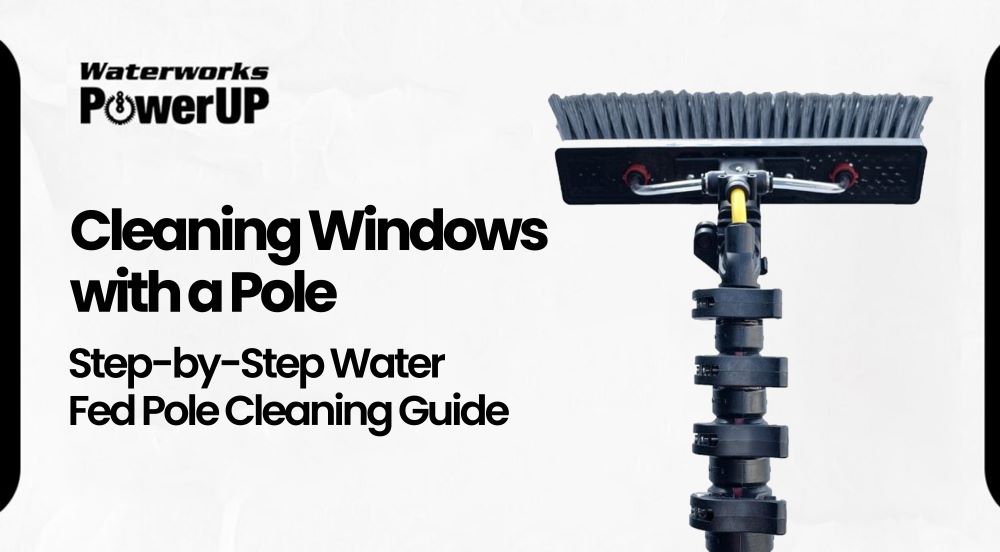Cleaning windows with a pole is the modern, ladder-free method used by professionals to achieve spotless results. Using a water fed pole system and pure water filtration, window cleaners can reach high windows safely while preventing streaks and mineral spots—ideal for domestic and commercial cleaning.
Key Facts
- Water-fed poles reach up to 60–70 ft, allowing safe cleaning from the ground.
- Pure water systems remove minerals and impurities, leaving spot-free glass without chemicals.
- A complete Waterworks setup (tank, reel, pole) can pay for itself in 3–6 months of active use.
- Telescopic poles and lightweight carbon-fibre designs reduce fatigue and make high-reach cleaning easier.
- Always match your pump, hose, and reel type to ensure stable water flow and pressure.
- All Waterworks systems and accessories are engineered for pure-water performance and commercial-grade durability.

In This Article
Introduction
For today’s professional cleaners, cleaning windows with a pole has become the safest, fastest, and most efficient way to achieve perfect, streak-free glass. Instead of climbing ladders or relying on traditional squeegees, modern water fed pole systems use purified water and extendable poles to deliver superior results — all from the ground.
This technique, known as pure water window cleaning, removes dust, debris, and mineral build-up without leaving marks behind. The water travels through a telescopic pole connected to a filtration system, allowing professionals to clean even high or hard-to-reach windows with precision and safety.
Whether you’re just starting with pure water technology or upgrading your equipment, this guide covers everything you need — from essential tools and setup steps to expert cleaning techniques and safety best practices.
What You Need for Cleaning Windows with a Pole

Cleaning windows with a pole requires more than just a brush and some water — it’s about using the right tools designed for pure-water window cleaning. With the correct setup, you’ll achieve streak-free glass, faster results, and complete safety when working from the ground.
Essential Equipment List
Before you start, make sure you have all the core components of a modern water fed pole cleaning setup:
- Telescopic or extension pole — Adjustable, lightweight, and available in carbon-fibre or aluminium for strength and comfort.
- Brush head — Choose a soft-bristle or dual-trim brush with fan or pencil jets to control the water flow evenly across glass surfaces.
- Pure water system — Either DI or RO/DI filtration, depending on your water hardness, to remove minerals and deliver spot-free glass.
- Hose reel & fittings — Keep your hoses organised and ensure consistent water pressure.
- Safety gear — Non-slip boots, gloves, and a stable ground area for working safely at height.
💡 Tip: Always use poles designed for professional window cleaning — they’re lighter, more durable, and ensure better reach for hard-to-access windows.
Recommended System Setup (Tank, Hose Reel, and Pole Type)
Your system setup directly affects performance and water quality. A balanced combination of pump, reel, and pole ensures reliable flow and efficient cleaning:
- Water tank: Start with a 500 L DI system or upgrade to a 750 L RO/DI system for full van-mounted operation.
- Hose reel: Manual or electric reels help manage hose length and prevent tangling — explore the PowerUP XL Hose Reel → for professional setups.
- Pole selection: Choose pole height based on project type — 25 ft for domestic, 40–70 ft for commercial or multi-storey work.
✅ Pro Tip: Match your pump pressure and reel type carefully — too much pressure can cause over-spray, while low pressure affects water flow.
For complete systems that integrate tank, reel, and pole, check out our Window Cleaning System Builder → to design your own setup.
Optional Accessories to Improve Performance
Take your results to the next level with performance add-ons designed for comfort and efficiency:
- Angle adapters & clamps — Perfect for cleaning windows at height or tricky corners.
- Brush upgrades — Switch between soft-bristle and flocked brushes for different surfaces.
- TDS meter — To ensure your water remains at 0 ppm purity for streak-free window cleaning.
- Spare hoses & fittings — Keep backups to prevent downtime on-site.
- Pole clamps & extensions — Extend reach or adjust flexibility depending on the job type.
Step-by-Step — How to Clean Windows Using a Water Fed Pole
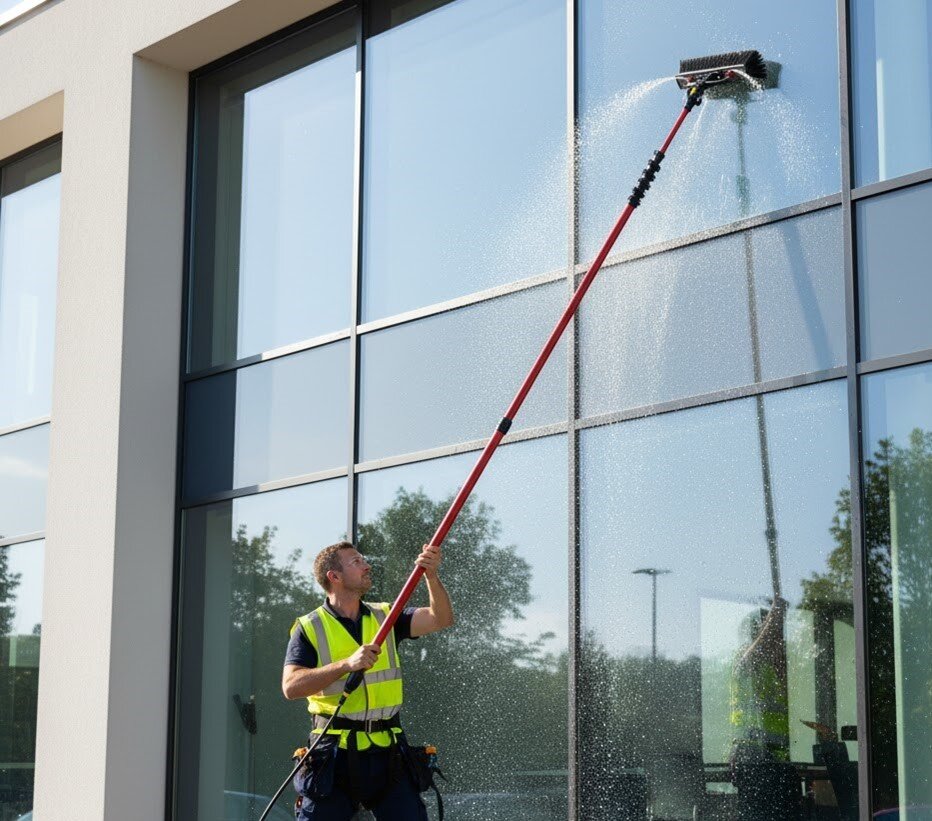
Once your water fed pole system is set up, it’s time to put it to work. Follow these professional steps to achieve streak-free, spotless glass every time — whether you’re cleaning at home or on a commercial site.
Step 1 — Preparing the Pure Water System
Before touching the glass, make sure your pure water system is working correctly:
- Check your TDS reading — ensure it’s 0 ppm for mineral-free, spot-free cleaning.
- Fill your tank using the RO/DI or DI filtration system, depending on your setup.
- Connect your hose reel and pole securely to avoid leaks or reduced pressure.
- Test the flow rate — steady water pressure ensures proper rinsing and coverage.
💧 Pro Tip: Always pre-rinse your brush before use to remove dust buildup from storage.
Step 2 — Scrub from Top to Bottom Using a Telescopic Pole
Now, position your telescopic pole slightly angled toward the window for better control:
- Start at the top frame and gently move the brush in slow, overlapping strokes.
- Allow water jets to flush away dust, cobwebs, and bird droppings.
- Work your way downwards, maintaining even brush pressure to loosen grime.
- Focus on corners and edges where mineral spots usually form.
🌟 Bonus Tip: If you’re working at height, extend the pole gradually to maintain balance and avoid fatigue.
Step 3 — Rinse for a Spot-Free Finish
Rinsing is the key to streak-free glass. Keep your brush just above the surface and rinse thoroughly:
- Use fan jets for initial heavy cleans and pencil jets for lighter maintenance washes.
- Maintain a steady water flow while moving the brush horizontally from top to bottom.
- Let the pure water air-dry — no towels or squeegees needed.
✅ Remember: Avoid rinsing in direct sunlight — quick evaporation may cause mineral residue.
Step 4 — Check Your Work and Let It Dry Naturally
After rinsing, take a quick step back and inspect your results:
- Look for any remaining streaks or marks, especially near window frames and sills.
- Touch up corners using a small detail brush or angle adapter if needed.
- Allow 10–15 minutes for natural drying — pure water will leave a crystal-clear finish.
🧽 Maintenance Tip: Always flush your system after every use to prevent buildup and extend filter life.
Pro Technique Tips for Streak-Free Results
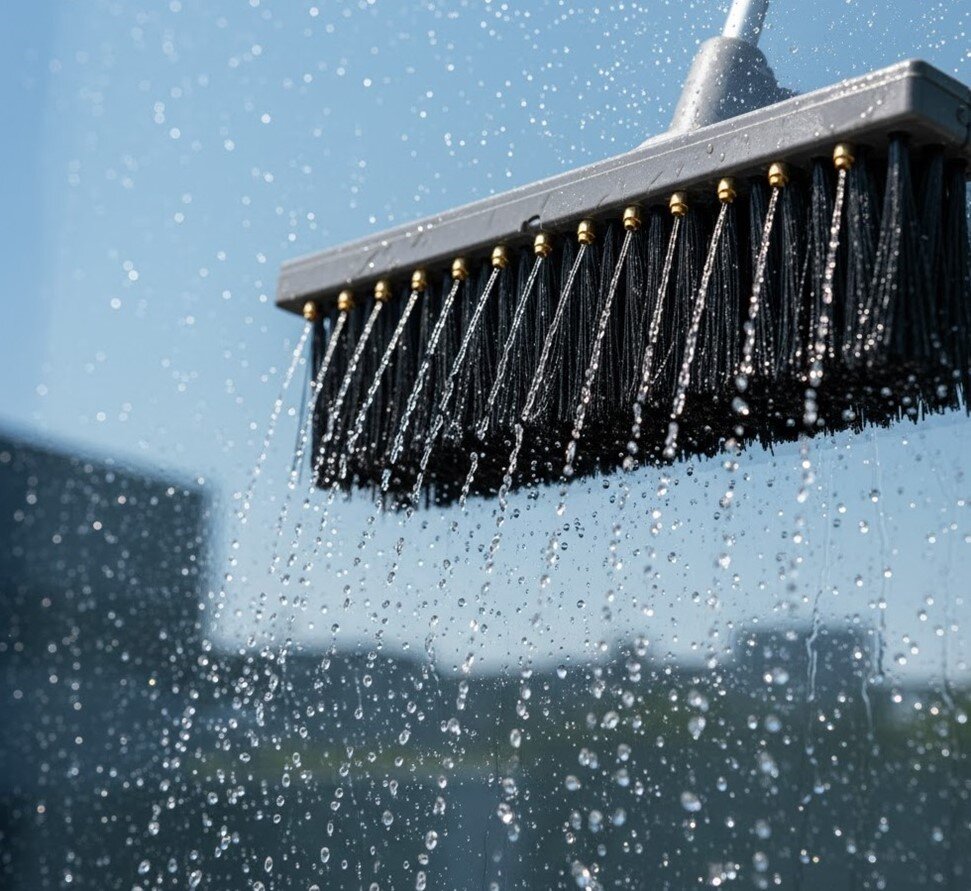
Even with the best water fed pole system, small mistakes or poor technique can leave streaks behind. These pro tips will help you achieve spotless results on every clean — whether it’s a domestic job or multi-storey commercial property.
Keep Brush Bristles Soft and Clean
Dirty or worn-out brushes are one of the most common causes of streaks.
- Rinse your brush head before each use to remove grit and debris.
- Avoid pressing too hard; let the pure water and bristles do the work.
- Replace brush heads every few months, depending on usage.
🧽 Pro Pick: Use a soft-bristle or medium-trim brush head for smoother glide and even water coverage.
Use the Right Jets for Every Clean
Choosing between fan jets and pencil jets can make all the difference:
- Fan jets — Ideal for first-time cleans and large windows with heavy dirt.
- Pencil jets — Perfect for regular maintenance cleans and spot-free drying.
💧 Pro Tip: Adjust your water flow and jet angle to ensure complete coverage without overspray.
Control Water Temperature and Angle
While cleaning windows with a pole, maintaining the right temperature and brush angle helps prevent streaking:
- Use lukewarm water in cold weather to break down dirt faster.
- Keep your pole angle around 45° to improve water runoff and reduce fatigue.
- Avoid direct sunlight or strong wind — quick drying can leave mineral shadows.
🌤️ Bonus Tip: For difficult sills or skylights, use an angle adapter for better reach and precision.
Maintain Proper Rinsing Distance
Rinsing too close can create water marks, while being too far leaves unwashed areas.
- Hold the pole so water just skims over the glass surface.
- Keep consistent motion and overlap each stroke slightly.
- End with a final top-to-bottom rinse for an even finish.
✅ Pro Reminder: If you notice faint spots after drying, check your TDS reading — it should always stay at 0 ppm for perfect results.
Optional Squeegee Finish for Commercial Jobs
Although pure water window cleaning doesn’t require manual drying, professionals sometimes use squeegees for specific commercial applications:
- Use a lightweight extension pole squeegee for showrooms or shopfronts.
- Combine with pure water rinse to prevent streaks or detergent marks.
- Always start from the top frame and move in a single downward motion.
Common Mistakes to Avoid When Cleaning Windows with a Pole
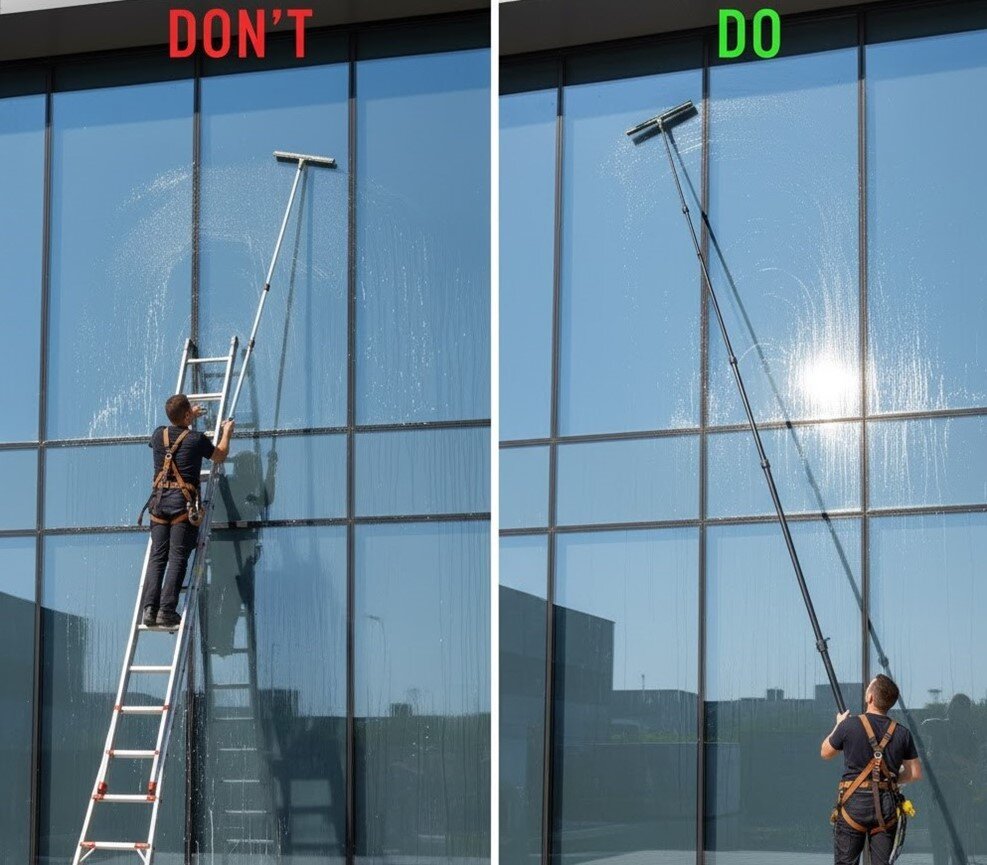
Even experienced cleaners can make small errors that affect results. Avoiding these common window cleaning mistakes will help extend the life of your equipment and keep your clients’ glass perfectly spotless.
Using Tap Water Instead of Purified Water
One of the biggest mistakes beginners make is skipping the pure water filtration process. Tap water contains minerals that cause white marks and streaks.
- Always use a DI or RO/DI system to produce 0 ppm pure water.
- Check your TDS meter before every job.
- Replace resin or filters regularly for consistent performance.
Over-Extending Poles Without Locking Clamps
Extending your telescopic pole too far without tightening clamps can lead to instability or even breakage.
- Always lock each section firmly before lifting.
- Don’t exceed the recommended maximum height for your pole.
- Regularly inspect clamps and pole ends for wear.
Not Cleaning Frames Before the Glass
Skipping frame cleaning can transfer dirt onto freshly rinsed windows.
- Start by scrubbing frames and sills first, then move to glass.
- Rinse frames thoroughly to prevent drips or streaks.
- Use a separate soft-bristle brush head for frames to avoid cross-contamination.
Tangled Hoses and Poor Reel Management
Poor hose handling wastes time and can damage fittings or restrict water flow.
- Always unreel your hose fully before starting work.
- Use a manual or electric hose reel to control tension.
- Wind hoses neatly after every job to avoid kinks.
Over-Rinsing or Working Too Fast
Too much rinsing or rushing the process often causes spotting.
- Allow pure water to dwell for a few seconds before rinsing.
- Don’t flood frames — moderate flow gives better drying.
- Slow, even movements create a consistent, streak-free finish.
Cleaning High Windows Without a Ladder — Safety at Height

One of the biggest advantages of cleaning windows with a pole is that you can reach upper floors safely — no ladders, no scaffolding, and no risk. With the right telescopic water fed pole system, professional window cleaners can easily clean windows up to 60–70 feet from ground level.
Maintain a Stable Stance and Controlled Movement
Your safety begins with how you position yourself.
- Keep your feet shoulder-width apart for balance.
- Face the window directly instead of working sideways.
- Avoid leaning or over-reaching — always let the extension pole do the work.
💡 Tip: Uneven ground or soft grass can affect stability. Adjust your footing or use anti-slip mats when needed.
Use Proper PPE and Safety Gear
Even though you’re cleaning from the ground, proper protection is essential.
- Wear non-slip safety boots, waterproof gloves, and a high-visibility vest when working roadside.
- Use safety cones or warning signs when cleaning in public or commercial areas.
- Keep cables and hoses away from walkways to avoid tripping hazards.
Check for Overhead Cables and Weather Conditions
Before extending your pole, always look up.
- Avoid working near electrical lines or communication cables.
- High wind can make long poles unstable — postpone work if gusts exceed safe levels.
- Extreme heat or direct sunlight can cause faster drying and spotting; work in shade where possible.
⚡ Pro Safety Note: Regularly inspect your carbon-fibre poles for cracks or wear before use.
Choose the Right Pole Length for the Job
Selecting the correct telescopic pole height ensures both comfort and control.
- 25 ft: Ideal for domestic properties.
- 40–50 ft: For small commercial buildings or second-storey cleans.
- 60–70 ft: For larger commercial or apartment blocks.
✅ Pro Tip: Always balance weight and flexibility — longer poles can tire your arms faster if not properly supported.
Use Van-Mounted or Delivery-Only Systems for Height Work
For high-access sites, van-mounted or delivery systems provide better water pressure and stability.
- Van systems offer larger tanks (500–1000L) for long jobs.
- Delivery-only setups are portable and perfect for multi-location work.
How to Clean Window Frames and Edges Using a Pole
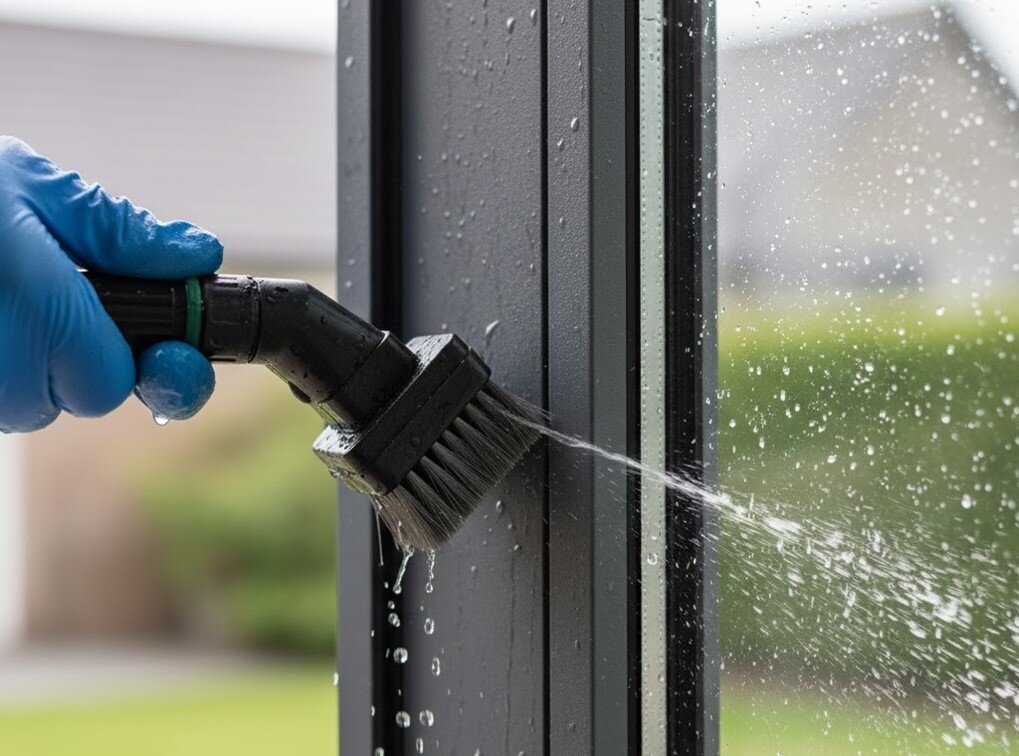
When it comes to cleaning windows with a pole, the frames and edges are where most streaks or water marks start. Dust, spider webs, and trapped debris on frames often drip down the glass during rinsing — that’s why every professional cleaner gives frames equal attention before and after cleaning.
Always Clean Frames Before the Glass
Start every job by rinsing and scrubbing the frames before touching the window itself.
- Use a soft-bristle brush head or a flocked dual-trim brush for safe scrubbing.
- Rinse the top and side frames to remove dirt before washing the glass.
- Avoid over-saturating frames; light water flow is enough to flush dust and pollen.
💡 Pro Tip: Keeping a dedicated frame brush prevents cross-contamination between dirty frames and clean glass.
Use Angle Adapters for Better Reach
Windows on upper floors or awkward angles (like conservatories or skylights) require precision.
- Attach an angle adapter or gooseneck connector to reach high corners easily.
- Maintain a steady water flow while brushing around edges.
- Keep your wrist relaxed — over-flexing causes uneven pressure and streaks.
Remove Build-Up and Residue from First Cleans
If you’re cleaning windows for the first time or after long intervals, expect heavy build-up.
- Scrub frames and sills twice to loosen grime and paint residue.
- For stubborn marks, use a non-abrasive scraper or stain remover approved for window frames.
- Rinse again using pure water to flush away loosened debris before moving to glass.
Prevent Streak Transfer from Frames
After rinsing, residual water from dirty frames can drip onto clean glass.
- Always finish the frame rinse last using a lighter flow.
- Wait a few seconds before rinsing the window itself.
- Tilt the pole slightly outward to direct water away from frames during the final rinse.
✅ Pro Reminder: Pure water + good control = perfect, streak-free drying.
Are Water Fed Poles Durable and Worth the Investment?
Investing in a water fed pole system isn’t just about cleaning windows faster — it’s about working smarter, safer, and more profitably. When properly maintained, high-quality poles and systems from Waterworks can easily last for years while delivering consistent, professional results.
Carbon Fibre vs Aluminium — Which Is Better?
The two most common pole materials — carbon fibre and aluminium — each have their advantages:
- Carbon Fibre: Lightweight, rigid, and perfect for high-reach jobs. Reduces fatigue and improves control.
- Aluminium: More affordable and durable for short or medium-reach work. Excellent for beginners or backup poles.
💡 Pro Tip: Professionals often keep both types — carbon fibre for tall cleans and aluminium for quick, everyday use.
Maintenance Routine for Long-Term Performance
Just like any professional tool, regular maintenance keeps your pole system working like new:
- Rinse poles and brush heads after every job.
- Inspect clamps, hose fittings, and jets for wear.
- Replace worn-out clamps or brushes before they cause uneven cleaning.
- Store poles upright and out of direct sunlight.
Cost Recovery and ROI for Professionals
For professionals, water fed pole systems quickly pay for themselves through efficiency:
- Faster cleaning: Cover more properties per day, especially on multi-storey buildings.
- Lower labour costs: Work solo without needing ladders or extra staff.
- Increased safety: Fewer accidents and downtime mean higher profitability.
💷 Typical ROI: A complete Waterworks system (tank, reel, and pole) can recover its cost in 3–6 months of regular commercial use.
Frequently Asked Questions
How to squeegee with an extension pole?
If you prefer a manual finish, attach a lightweight extension-pole squeegee with a swivel handle. Work from top to bottom using overlapping strokes. For best results, rinse with pure water first and let it dry naturally — you’ll only need the squeegee for detailing.
Do water-fed poles really work for window cleaning?
Yes. Water-fed poles are the industry standard for streak-free window cleaning. They use purified water that removes dirt and minerals, leaving glass spotless without chemicals. They’re faster, safer, and ideal for both domestic and commercial work.
Are extendable poles durable enough for professional use?
Absolutely. High-quality carbon-fibre and aluminium poles are built for long-term use. With regular maintenance — cleaning clamps, checking fittings, and storing properly — your pole can easily last several years of daily operation.
How do you clean windows that are too high to reach?
Use a 60–70 ft telescopic water-fed pole to reach upper floors safely from the ground. For very tall buildings, a van-mounted RO/DI system maintains pressure and flow for efficient cleaning.
What is the best pure-water system for professionals?
That depends on your work type and region:
- DI systems for soft-water areas or smaller routes.
- RO/DI systems for hard-water or large commercial setups.
All Waterworks systems deliver 0 ppm water purity for a perfect finish every time.
Related Guides and Next Steps
Learning the correct way of cleaning windows with a pole is only the beginning. With the right technique and equipment, you can clean faster, safer, and more efficiently — whether you’re a solo professional or managing a full window cleaning business.
Here are a few useful resources from Waterworks to help you continue improving your workflow and results:
Learn the full setup process, from filtration to hose connection.
Find out which reel suits your work style and system capacity.
Understand how pure water delivers streak-free results.
Explore must-have accessories for your cleaning kit.
Final Thoughts
Cleaning windows with a pole is the safest, most efficient, and professional method to achieve spotless results. With Waterworks’ pure water technology, durable poles, and smart hose reel systems, every clean becomes faster, safer, and more profitable.
Waterworks continues to innovate UK-made window cleaning systems designed for everyday professionals — built to perform, built to last.

